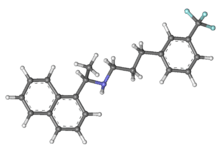Cinacalcet
 | |
 | |
| Clinical data | |
|---|---|
| AHFS/Drugs.com | Monograph |
| MedlinePlus | a605004 |
| License data |
|
| Pregnancy category | |
| Routes of administration | Oral |
| ATC code | H05BX01 (WHO) |
| Legal status | |
| Legal status |
|
| Pharmacokinetic data | |
| Bioavailability |
20 to 25% Increases if taken with food |
| Protein binding | 93 to 97% |
| Metabolism | Hepatic (CYP3A4-, CYP2D6- and CYP1A2-mediated) |
| Biological half-life | 30 to 40 hours |
| Excretion | Renal (80%) and fecal (15%) |
| Identifiers | |
| |
| CAS Number |
226256-56-0 |
| PubChem (CID) | 156419 |
| IUPHAR/BPS | 3308 |
| DrugBank |
DB01012 |
| ChemSpider |
137743 |
| UNII |
UAZ6V7728S |
| KEGG |
D03504 |
| ChEBI |
CHEBI:48390 |
| ChEMBL |
CHEMBL1201284 |
| ECHA InfoCard | 100.208.116 |
| Chemical and physical data | |
| Formula | C22H22F3N |
| Molar mass | 357.412 g/mol |
| 3D model (Jmol) | Interactive image |
| |
| |
| | |
Cinacalcet (INN) is a drug that acts as a calcimimetic (i.e. it mimics the action of calcium on tissues) by allosteric activation of the calcium-sensing receptor that is expressed in various human organ tissues (Van Wagenen et al. (2001), U.S. Pat. 6,211,244). It is sold by Amgen under the trade name Sensipar in North America and Australia and as Mimpara in Europe. Cinacalcet is used to treat secondary hyperparathyroidism (elevated parathyroid hormone levels), a consequence of end-stage renal disease.[1] Cinacalcet is also indicated for the treatment of hypercalcemia in patients with parathyroid carcinoma.[2] Cinacalcet was FDA approved in March 2004,[3] and was the first allosteric G protein-coupled receptor modulator to enter the pharmaceutical market.[4] In 2014, cinacalcet was 76th out of the top 100 drugs in the list of largest selling pharmaceutical products.
Medical uses
Cinacalcet is indicated for the treatment of tertiary hyperparathyroidism in people with chronic kidney disease on dialysis and hypercalcemia in people with parathyroid carcinoma.[5] Cinacalcet can also be used to treat severe hypercalcemia in patients with primary hyperparathyroidism who are unable to undergo parathyroidectomy.[6]
In the treatment of tertiary hyperparathyroidism due to chronic kidney disease on dialysis it does not appear to affect mortality.[7] It does decrease the need for a parathyroidectomy but caused more issues with low blood calcium levels.[7]
Contraindications
Hypocalcemia (decreased calcium levels) is a contraindication of cinacalcet. Patients who have serum calcium levels less than 7.5 mg/dL should not be started on cinacalcet. Hypocalcemia symptoms include parathesias, myalgias, muscle cramping, tetany, and convulsions. Cinacalcet should not be administered until serum calcium levels are above 8.0 mg/dL and/or hypocalcemia symptoms are resolved.[3]
Adverse effects
Common side effects of cinacalcet include:[6]
- Stomach upset
- Vomiting
- Diarrhea
- Dizziness
- Nausea
- Weakness
- Chest pain
Clinical trials conducted in the United States by Amgen to determine whether the drug is safe for children were halted by the FDA in February 2013 following the death of a 14-year-old patient.[8]
Overdose
Serious side effects, including overdose symptoms, of cinacalcet include:[6]
- Burning
- Tingling
- Unusual feelings of the lips, tongue, fingers, or feet
- Muscle aches or cramps
- Sudden tightening of muscles in hands, feet, face, or throat
- Seizures
Drug interactions
Cinacalcet is a strong CYP2D6 inhibitor and is partially metabolized by CYP3A4 and CYP1A2. Dose adjustments may be necessary if patients are on CYP3A4 and CYP1A2 inhibitors and medications that are metabolized by CYP2D6.[3]
Dosing
Cinacalcet is taken orally and comes in tablet form in three strengths (30 mg, 60 mg, and 90 mg).[9] The tablet should not be split, chewed, or crushed. Cinacalcet should be taken with food or after a meal for increased absorption of the medication. Cinacalcet dosing is patient dependent and individualized.[6]
Monitoring
Secondary Hyperparathyroidism in Patients with Chronic Kidney Disease on Dialysis
Intact parathyroid hormone (iPTH) levels should be monitored and should not be measured earlier than 12 hours after the last dose. iPTH levels are usually measured 1 to 4 weeks after the initiation dose or dose adjustment, and every 1 to 3 months after the maintenance dose is established. Serum calcium and phosphorus levels should be within 1 week after starting cinacalcet or after dose adjustment. Once the maintenance dose is established, serum calcium should be measured monthly.[3]
Parathyroid Carcinoma or Primary Hyperparathyroidism
Serum calcium should be measured 1 week after initiation or dose adjustment of cinacalcet, and every 2 months once the maintenance dose has been established.[3]
Safety in pregnancy and lactation
Pregnancy
Cinacalcet is category C in pregnancy. Adequate and well-controlled studies involving cinacalcet in pregnant women have not been done; therefore cinacalcet should only be used during pregnancy if the benefit outweighs the potential risk to the fetus.[3]
Lactation
Studies have not been done in lactating women; therefore it is not known whether cinacalcet is excreted in human milk.[3]
Mechanism of action
Cinacalcet is a drug that acts as a calcimimetic (i.e. it mimics the action of calcium on tissues) by allosteric activation of the calcium-sensing receptor that is expressed in various human organ tissues. The calcium-sensing receptors on the surface of the chief cell of the parathyroid gland is the principal regulator of parathyroid hormone secretion (PTH).[10] Cinacalcet increases the sensitivity of calcium receptors on parathyroid cells to reduce parathyroid hormone (PTH) levels and thus decrease serum calcium levels.[5] As receptors are already active from the calcimimetic (Cinacalcet) the native rise and fall of Ca levels now interact with the remaining receptors, effectively lowering the threshold for activation of feedback on the parathyroid chief cells.
References
- ↑ Torres PU (2006). "Cinacalcet HCl: a novel treatment for tertiary hyperparathyroidism caused by chronic kidney disease". Journal of Renal Nutrition. 16 (3): 253–8. doi:10.1053/j.jrn.2006.04.010. PMID 16825031.
- ↑ "Sensipar for Parathyroid Carcinoma". Amgen. 2009. Retrieved 25 September 2009.
- 1 2 3 4 5 6 7 {{Amgen. . Retrieved 29 October 2014.}}
- ↑ Bräuner-Osborne H, Wellendorph P, Jensen AA (2007). "Structure, pharmacology and therapeutic prospects of family C G-protein coupled receptors". Current Drug Targets. 8 (1): 169–84. doi:10.2174/138945007779315614. PMID 17266540.
- 1 2 2014 Nurses Drug Handbook (13th ed.). Burlington, MA: Jones & Bartlett Learning. 2014. pp. 245–6. ISBN 978-1-284-03115-7.
- 1 2 3 4 {{U.S. National Library of Medicine. . Retrieved 29 October 2014.}}
- 1 2 Ballinger, AE; Palmer, SC; Nistor, I; Craig, JC; Strippoli, GF (9 December 2014). "Calcimimetics for tertiary hyperparathyroidism in chronic kidney disease patients.". The Cochrane database of systematic reviews. 12: CD006254. doi:10.1002/14651858.CD006254.pub2. PMID 25490118.
- ↑ Edney, Anna (February 26, 2013). "Amgen Pediatric Trials of Sensipar Halted by FDA After Death". Businessweek.
- ↑ Sensipar (Cinacalcet). Amgen. . Retrieved 29 October 2014.
- ↑ http://www.drugbank.ca/drugs/DB01012
External links
- Sensipar website run by Amgen
- Prescribing information (package insert)
- Cinacalcet - Medlineplus.org
- Cinacalcet - Drug Digest.